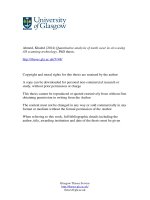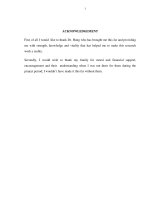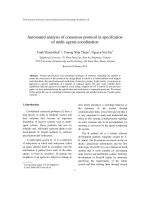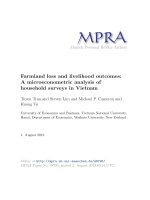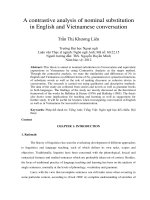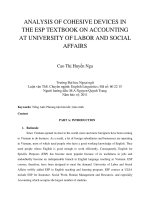Analysis of distributed beamforming in cooperative communications network with phase shifter based smart antenna nodes
Bạn đang xem bản rút gọn của tài liệu. Xem và tải ngay bản đầy đủ của tài liệu tại đây (2.88 MB, 154 trang )
Analysis of Distributed
Beamforming in Cooperative
Communications Networks with
Phase Shifter Based Smart
Antenna Nodes
by
Tharunie Baleshan
Thesis
Submitted for the Degree of
Master of Engineering
Queensland University of Technology
Science and Engineering Faculty
2015
QUT Verified Signature
To My Parents
For their endless love, support and encouragement
Keywords
Smart antennas, Distributed beamforming, Cooperative diversity, Power Minimisation, SNR Maximisation, Array factor, Directivity, Field intensity
Abstract
Performance of wireless communications systems can be significantly improved
by means of multiple antennas at communicating terminals. However, due to limitation of the physical size and the cost, employing large number of antennas at
communicating terminals becomes infeasible. As a remedy, cooperative communication was proposed where different users share their antennas and thus cooperate
for the source-to-destination communication. It is desirable to maximise receiver
quality-of-service (QoS) in terms of Signal-to-Noise Ratio (SNR) and also to minimise the cost of transmission in terms of power. Transmit power of relays and
received SNR are major concerns in designing such a communication network
and significant literature focusses on minimisation of the total transmit power of
relays subject to received SNR or maximisation of the received SNR at the destination subject to total transmit power of relays. However, most of these previous
studies consider either single antenna relays or Multiple-Input-Multiple-Output
(MIMO) relays. Though the MIMO relays give better performance over single
antenna relays, their hardware configuration is much more complex because each
antenna requires a separate receiver/transmitter module. Smart antenna systems
can also improve the performance with only much simpler hardware, as they require only a single receiver/transmitter module. Furthermore, above mentioned
optimisations are often investigated separately and trade-off between those two
optimisations is not fully explored.
Geographically separated relays can cooperatively adjust their amplitude and
viii
phase excitations and these excitations are calculated by optimising the performance of wireless communication. An array’s radiation pattern can be continuously steered by adaptively changing the phase excitation of the antenna array
without additional power in mobile communication. Conventional approach to
shape the beam is to maximise the field intensity at the destination. However, in
this research study maximising directivity is investigated for circular and linear
arrays, and it is shown that directivity maximisation outperforms the field intensity maximisation to save power. Hence, directivity maximisation is incorporated
with distributed beamforming to analyse the performance improvement of the
communication.
In addition to power minimisation in receive and transmit beamforming processes,
directivity from each relay to the source and the destination is maximised. For
the transmit beamforming, the complex beamforming weight of each relay is
then calculated to minimise the total transmit power of relays, while maintaining
SNR at the destination above a predefined threshold. We also calculated the total
power gain achieved with the smart antenna system and compared it to the single
antenna relays case with distributed beamforming. Results show that the total
power gain which exceeds the sum of the smart antenna gains can be achieved
for high levels of the SNR thresholds at the destination.
Next, a comparison of relay power minimisation subject to received SNR at the
destination and SNR maximisation subject to the total transmit power of relays
for a typical wireless network with distributed beamforming is considered. In this
research study, it is shown that SNR maximisation subject to power constraint
and power minimisation subject to SNR constraint yield the same result for a
typical wireless network. It is concluded that either one of the optimisation
approaches is sufficient to simultaneously minimise the transmit power at the
relays and to maximise the SNR at the destination.
Table of Contents
Keywords
Abstract
v
vii
Table of Contents
ix
List of Figures
xi
List of Tables
Acronyms & Abbreviations
Variables & Notations
Acknowledgments
1 Introduction
xiii
xv
xvii
xix
1
1.1
General . . . . . . . . . . . . . . . . . . . . . . . . . . . . . . . .
1
1.2
Motivation . . . . . . . . . . . . . . . . . . . . . . . . . . . . . . .
3
1.3
Research Problems . . . . . . . . . . . . . . . . . . . . . . . . . .
4
x
Table of Contents
1.4
Objectives and Methodology . . . . . . . . . . . . . . . . . . . . .
5
1.5
Contributions and Significance . . . . . . . . . . . . . . . . . . . .
6
1.5.1
Publications . . . . . . . . . . . . . . . . . . . . . . . . . .
8
1.6
Scope of the Proposed Project . . . . . . . . . . . . . . . . . . . .
8
1.7
Organisation of the Thesis . . . . . . . . . . . . . . . . . . . . . .
9
2 Background
11
2.1
Cooperative Communication . . . . . . . . . . . . . . . . . . . . .
12
2.2
Beamforming . . . . . . . . . . . . . . . . . . . . . . . . . . . . .
14
2.3
Distributed Beamforming . . . . . . . . . . . . . . . . . . . . . . .
16
2.4
Minimum Power and Maximum SNR . . . . . . . . . . . . . . . .
20
2.5
Gaps in the Existing Literature . . . . . . . . . . . . . . . . . . .
20
2.6
Summary . . . . . . . . . . . . . . . . . . . . . . . . . . . . . . .
21
3 Antenna Arrays
3.1
3.2
3.3
23
Radiation Pattern . . . . . . . . . . . . . . . . . . . . . . . . . . .
24
3.1.1
Isotropic Antennas . . . . . . . . . . . . . . . . . . . . . .
24
Antenna Power . . . . . . . . . . . . . . . . . . . . . . . . . . . .
25
3.2.1
Radiation Power Density . . . . . . . . . . . . . . . . . . .
25
3.2.2
Radiation Intensity . . . . . . . . . . . . . . . . . . . . . .
27
3.2.3
Directivity . . . . . . . . . . . . . . . . . . . . . . . . . . .
27
3.2.4
Gain . . . . . . . . . . . . . . . . . . . . . . . . . . . . . .
28
Antenna Aperture . . . . . . . . . . . . . . . . . . . . . . . . . . .
28
Table of Contents
xi
3.4
Mutual Coupling . . . . . . . . . . . . . . . . . . . . . . . . . . .
29
3.5
Array Factor . . . . . . . . . . . . . . . . . . . . . . . . . . . . . .
29
3.5.1
Array Factor of Linear and Circular Antenna Arrays . . .
31
Antenna Arrays . . . . . . . . . . . . . . . . . . . . . . . . . . . .
31
3.6.1
Antenna Architectures of Communication Terminals . . . .
38
3.7
Digital Phase Shifter . . . . . . . . . . . . . . . . . . . . . . . . .
39
3.8
Summary . . . . . . . . . . . . . . . . . . . . . . . . . . . . . . .
43
3.6
4 Optimisation of Directivity
4.1
4.2
4.3
Optimisation of Circular Antenna Arrays . . . . . . . . . . . . . .
46
4.1.1
Field Intensity Maximisation . . . . . . . . . . . . . . . . .
46
4.1.2
Directivity Maximisation . . . . . . . . . . . . . . . . . . .
48
4.1.2.1
With Digital Phase Shifters . . . . . . . . . . . .
53
Optimisation of Linear Antenna Arrays . . . . . . . . . . . . . . .
60
4.2.1
Field Intensity Maximisation . . . . . . . . . . . . . . . . .
60
4.2.2
Directivity Maximisation . . . . . . . . . . . . . . . . . . .
61
Summary . . . . . . . . . . . . . . . . . . . . . . . . . . . . . . .
65
5 Power Minimisation
5.1
45
67
Calculation of Power and SNR . . . . . . . . . . . . . . . . . . . .
68
5.1.1
Optimisation . . . . . . . . . . . . . . . . . . . . . . . . .
73
5.2
Simulation Results . . . . . . . . . . . . . . . . . . . . . . . . . .
75
5.3
Summary . . . . . . . . . . . . . . . . . . . . . . . . . . . . . . .
85
xii
Table of Contents
6 Optimisation Duality
87
6.1
SNR Maximisation . . . . . . . . . . . . . . . . . . . . . . . . . .
88
6.2
Summary . . . . . . . . . . . . . . . . . . . . . . . . . . . . . . .
93
7 Conclusions
95
7.1
Significant Research Outcomes . . . . . . . . . . . . . . . . . . . .
96
7.2
Future Directions . . . . . . . . . . . . . . . . . . . . . . . . . . .
97
Appendix A MATLAB Code
99
A.1 Field Intensity Maximisation of Circular Antenna Array . . . . .
99
A.1.1 Field Intensity.m . . . . . . . . . . . . . . . . . . . . . . .
99
A.1.2 Field Intensity Nobit.m
. . . . . . . . . . . . . . . . . . . 100
A.1.3 Field Intensity Bit.m . . . . . . . . . . . . . . . . . . . . . 102
A.1.4 Field Intensity Bit optim.m . . . . . . . . . . . . . . . . . 104
A.2 Directivity Maximisation of Circular Antenna Array . . . . . . . . 105
A.2.1 Directivity.m . . . . . . . . . . . . . . . . . . . . . . . . . 105
A.2.2 Directivity Nobit.m . . . . . . . . . . . . . . . . . . . . . . 105
A.2.3 Directivity Nobit optim.m . . . . . . . . . . . . . . . . . . 107
A.2.4 Directivity Bit.m . . . . . . . . . . . . . . . . . . . . . . . 108
A.2.5 Directivity Bit optim.m . . . . . . . . . . . . . . . . . . . 109
A.3 Field Intensity Maximisation of Linear Antenna Array . . . . . . 110
A.3.1 Field Intensity Linear.m . . . . . . . . . . . . . . . . . . . 110
A.3.2 Field Intensity Linear Nobit.m
. . . . . . . . . . . . . . . 111
Table of Contents
xiii
A.4 Directivity Maximisation of Linear Antenna Array . . . . . . . . . 113
A.4.1 Directivity Linear.m . . . . . . . . . . . . . . . . . . . . . 113
A.4.2 Directivity Linear Nobit.m . . . . . . . . . . . . . . . . . . 114
A.4.3 Directivity Linear Nobit optim.m . . . . . . . . . . . . . . 115
References
117
List of Figures
2.1
Communication methods. . . . . . . . . . . . . . . . . . . . . . .
13
2.2
Beamforming. . . . . . . . . . . . . . . . . . . . . . . . . . . . . .
15
2.3
Distributed beamforming . . . . . . . . . . . . . . . . . . . . . . .
17
3.1
Azimuth and elevation planes. . . . . . . . . . . . . . . . . . . . .
24
3.2
Normalised radiation field pattern of an isotropic antenna. . . . .
25
3.3
Geometries of linear antenna array. . . . . . . . . . . . . . . . . .
32
3.4
Geometry of circular antenna array. . . . . . . . . . . . . . . . . .
33
3.5
3-element circular, isotropic antenna array with 0.5λ relative displacement.
3.6
. . . . . . . . . . . . . . . . . . . . . . . . . . . . . .
. . . . . . . . . . . . . . . . . . . . . . . . . . . . . .
35
3-element circular, isotropic antenna array with 0.5λ relative displacement and different amplitude excitations.
3.9
34
3-element circular, isotropic antenna array with 0.4λ relative displacement.
3.8
34
3-element linear, isotropic antenna array with 0.5λ relative displacement.
3.7
. . . . . . . . . . . . . . . . . . . . . . . . . . . . . .
. . . . . . . . . .
35
3-element circular, isotropic antenna array with 0.5λ relative displacement and different phase excitations. . . . . . . . . . . . . .
36
xvi
List of Figures
3.10 3-element infinitesimal horizontal dipole circular antenna array
with 0.5λ relative displacement. . . . . . . . . . . . . . . . . . . .
36
3.11 Radiation pattern for different number of antennas in an array. . .
37
3.12 Antenna architectures (a) single antenna, (b) MIMO terminal, (c)
Cooperative MIMO terminals and (d) smart antenna consisting
of a power splitter/combiner (PS/C), phase shifters and multiple
antennas. . . . . . . . . . . . . . . . . . . . . . . . . . . . . . . .
38
3.13 3-bit digital phase shifter (a). for bit pattern 011 with 135◦ phase
shift (b). for bit pattern 001 with 45◦ phase shift.
4.1
. . . . . . . .
A segment of a circular antenna array with M equally spaced elements. . . . . . . . . . . . . . . . . . . . . . . . . . . . . . . . . .
4.2
40
47
(a). Radiation pattern (b). Directivity plot, for M = 3, q = 0.4
for field intensity maximisation and directivity maximisation in the
direction, (θ0 , φ0 ) = (90◦ , 50◦ ). . . . . . . . . . . . . . . . . . . . .
4.3
50
(a). Radiation pattern (b). Directivity plot, for M = 4, q = 0.3
for field intensity maximisation and directivity maximisation in the
direction, (θ0 , φ0 ) = (90◦ , 90◦ ) . . . . . . . . . . . . . . . . . . . .
4.4
Maximum directivity versus azimuth angle of destination for M =
4 with different values of q and continuous phase shifter. . . . . .
4.5
53
Maximum directivity versus azimuth angle of destination for q =
0.4 with different values of M and continuous phase shifter. . . . .
4.6
52
54
Normalised radiation pattern for M = 3, q = 0.4 with phase
shifts optimised to achieve maximum directivity in the direction
(θ0 , φ0 ) = (90◦ , 50◦ ) with continuous phase shifter and 3-bit digital
phase shifter. . . . . . . . . . . . . . . . . . . . . . . . . . . . . .
55
List of Figures
4.7
xvii
Maximum directivity versus azimuth angle of destination for M =
3, q = 0.4 with different number of bits in the phase shifters. The
values for the considered example where φ0 = 50◦ are indicated
with dots. . . . . . . . . . . . . . . . . . . . . . . . . . . . . . . .
4.8
Probability distributions of maximum directivity for various configurations of antenna arrays. . . . . . . . . . . . . . . . . . . . .
4.9
57
58
Directivity for field intensity maximisation and directivity maximisation (a). M = 4 and q = 0.4. (b). M = 4, q = 0.5, with
continuous phase shifter . . . . . . . . . . . . . . . . . . . . . . .
59
4.10 Difference in directivity for both optimisations for M = 4 with
different inter-element spacing . . . . . . . . . . . . . . . . . . . .
60
4.11 Maximum directivity versus azimuth angle of destination for M =
3 with different values of q and continuous phase shifter . . . . . .
62
4.12 Maximum directivity versus azimuth angle of the destination for
linear array with M = 4 and q = 0.4 for field intensity maximisation and directivity maximisation. . . . . . . . . . . . . . . . . . .
62
4.13 Maximum directivity versus azimuth angle of the destination for
linear array with q = 0.5 for different number of antennas for field
intensity maximisation and directivity maximisation. . . . . . . .
63
4.14 Maximum directivity versus azimuth angle of the destination for
q = 0.4 with different values of M and continuous phase shifter. .
63
4.15 Radiation pattern and directivity plot for linear array with M =
4, q = 0.4 and the destination is in the direction of (θ0 , φ0 ) =
(90◦ , 20◦ ) for field intensity maximisation and directivity maximisation. . . . . . . . . . . . . . . . . . . . . . . . . . . . . . . . . .
64
xviii
List of Figures
4.16 Difference in directivity for both optimisations for M = 4 with
different inter element spacing. . . . . . . . . . . . . . . . . . . . .
65
5.1
Network model for single antenna relays with isotropic antennas. .
68
5.2
Network model for multi-antenna relays with isotropic antenna
elements with enhanced directivity for receive beamforming. . . .
5.3
69
Network model for multi-antenna relays with isotropic antenna
elements with enhanced directivity for transmit beamforming. . .
70
5.4
Location of the destination for simulation. . . . . . . . . . . . . .
76
5.5
Comparison of average minimum relay transmit power vs SNR
threshold for single and multiple antenna networks with different
αg for M = 3, q = 0.4 with 3-bit phase shifter in single antenna
relay network and multi-antenna relay network for αf = −5 dB. .
5.6
79
Power gain of multi-antenna relay network w.r.t single antenna
relay network vs SNR threshold for different αg for M = 3, q = 0.4
with 3-bit phase shifter for αf = −5 dB. . . . . . . . . . . . . . .
5.7
80
Comparison of average minimum relay transmit power vs SNR
threshold for single and multiple antenna networks with different
αf for M = 3, q = 0.4 with 3-bit phase shifter in single antenna
relay network and multi-antenna relay network for αg = −5 dB. .
5.8
81
Power gain of multi-antenna relay network w.r.t single antenna
relay network vs SNR threshold for different αf for M = 3, q = 0.4
with 3-bit phase shifter for αg = −5 dB. . . . . . . . . . . . . . .
5.9
82
Average minimum transmit power of relays using mean value of
directivity and exact value of directivity calculated for each relay
when αf = −10 dB and αg = −10 dB. . . . . . . . . . . . . . . .
83
List of Figures
xix
5.10 Comparison of average minimum relay transmit power vs SNR
threshold for single and multiple antenna networks with different
αf and αg for M = 3, q = 0.4 with 3-bit phase shifter in single antenna relay network and multi-antenna relay network with
transmit beamforming only. . . . . . . . . . . . . . . . . . . . . .
84
6.1
SNR maximisation results for αf = −5 dB and different values of αg 91
6.2
Power minimisation results for αf = −5 dB and different values of
αg when P0 = 0 dBW, σr2 = 0 dBW and σd2 = 0 dbW . . . . . . .
6.3
92
Comparison of power minimisation and SNR maximisation results
for αf = −5 dB and different values of αg when P0 = 0 dBW,
σr2 = 0 dBW and σn2 = 0 dbW . . . . . . . . . . . . . . . . . . . .
92
List of Tables
3.1
Excitations of antenna array . . . . . . . . . . . . . . . . . . . . .
37
3.2
Phase shift contributions.
. . . . . . . . . . . . . . . . . . . . . .
40
3.3
Few digital phase shifters in market. . . . . . . . . . . . . . . . .
42
4.1
Phase shifts for maximum directivity and maximum field intensity
in (90◦ , 50◦ ) direction for M = 3 and q = 0.4. . . . . . . . . . . . .
4.2
Phase shift for maximum directivity and maximum field intensity
in (90◦ , 90◦ ) direction for M = 4 and q = 0.3. . . . . . . . . . . . .
4.3
49
49
Achievable maximum directivity in a given direction when the directivity and the field intensity is maximised respectively for different antenna array architecture. . . . . . . . . . . . . . . . . . .
4.4
51
Phase shift for maximum directivity in (90◦ , 50◦ ) direction for M =
3 and q = 0.4 with 3-bit phase shifter and continuous phase shifter. 54
4.5
Statistical properties of maximum directivity for different values
of M , q and P . . . . . . . . . . . . . . . . . . . . . . . . . . . . .
56
Acronyms & Abbreviations
In alphabetical order,
AF
Amplify and Forward
CSI
Channel State Information
DF
Decode and Forward
MIMO
Multiple-Input-Multiple-Output
QoS
Quality of Service
SINR
Signal to Interference plus Noise Ratio
SNR
Signal to Noise Ratio

